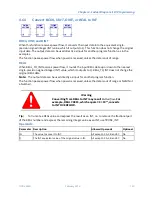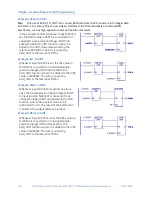
Chapter 4. Ladder Diagram (LD) Programming
GFK-2950C
February 2018
111
Parameter Description
Allowed Operands Optional
FTT
(Fault Timeout) If you use the FTT operand, you must also use
the TFT operand, and vice-versa. The FTT operand is the
starting address of Length words of memory, where Length is
the number of steps. Each FTT word corresponds to one word
of PTN. The value of each word represents the fault timeout for
the corresponding step of the Drum Sequencer in 0.1 second
units.
When the fault timeout has expired the Fault Timeout bit is set.
The programming software does not create an array for you.
You must ensure you allocate enough memory for FTT.
All except S, SA, SB,
SC and constant
Yes
Q
A word of memory containing the element of the PTN that
corresponds to the current Active Step.
All except S and
constant
No
DRC
(Drum Coil) Bit reference that is set whenever the function is
enabled and Active Step is
not
equal to Preset Step.
All except S
Yes
DTO
(Dwell Timeout) If you use the DTO operand, you must also use
DT and vice-versa. This bit reference is set if the dwell time for
the current step has expired.
All except S and
constant
Yes
TFT
(Timeout Fault ) If you use the TFT operand, you must also use
the FTT operand and vice-versa. Bit reference that is set if the
drum has
been in a particular step longer than the step’s
specified Fault Timeout.
All except S and
constant
Yes
FF
(First Follower ) The starting address of (Length/8+1) bytes of
memory, where Length is the number of steps. If MOD
(Length/8+1)>0, FF has (Length/8+1) bytes. Each bit in the
bytes of FF corresponds to one word of PTN. No more than one
bit in the FF bytes is ON at any time, and that bit corresponds
to the value of the Active Step. The first bit corresponds to an
Active Step value of one. The last used bit corresponds to an
Active Step value of Length.
All except S and
constant
Yes
Control Block for the Drum Sequencer Function
The control block for the Drum Sequencer function contains information needed to operate the
Drum Sequencer.
address
Active Step
a 1
Preset Step
a 2
Step Control
a 3
Timer Control
Active Step
The active step value specifies the element in the Pattern array to copy to the Out
output memory location. This is used as the array index into the Pattern, Dwell Time, Fault Timeout,
and First Follower arrays.
Preset Step
A word input that is copied to the Active Step output when the Reset is On.
Step Control
A word that is used to detect Off to On transitions on both the Step input and the
Enable input. The Step Control word is reserved for use by the function, and
must not be written to.
Timer Control
Two words of data that hold values needed to run the timer. These values are
reserved for use by the function and
must not be written to.
Summary of Contents for PACSystems RSTi-EP
Page 357: ......
Page 466: ...Chapter 9 Diagnostics GFK 2950C February 2018 451 ...
















































